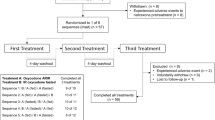Summary
Generally, oral administration is the route of choice in the daily practice of pharmacotherapy. However, in some circumstances this is impractical or even impossible (during nausea and vomiting or convulsions, in uncooperative patients and before surgery). In these cases, the rectal route may represent a practical alternative and rectal administration is now well accepted for delivering, for example, anticonvulsants, non-narcotic and narcotic analgesics, theophylline, antiemetics and antibacterial agents, and for inducing anaesthesia in children. It may also represent an interesting alternative to intravenous or other injection routes of drug administration.
The rate and extent of rectal drug absorption are often lower than with oral absorption, possibly an inherent factor owing to the relatively small surface area available for drug uptake. In addition, the composition of the rectal formulation (solid vs liquid, nature of the suppository base) appears to be an important factor in the absorption process by determining the pattern of drug release. This relation between formulation and drug uptake has been clearly demonstrated for drugs like diazepam, paracetamol (acetaminophen), indomethacin, methadone and diflunisal. Coadministration of absorption-promoting agents (surfactants, sodium salicylate, enamines) represents another approach towards manipulating rectal drug absorption, although this concept requires further research concerning both efficacy and safety.
For a number of drugs the extent of rectal absorption has been reported to exceed oral values, which may reflect partial avoidance of hepatic first-pass metabolism after rectal delivery. This phenomenon has been reported for morphine, metoclopramide, ergotamine, lidocaine (lignocaine) and propranolol. Rectal drug delivery in a site- and rate-controlled manner using osmotic pumps or hydrogel formulations may provide opportunities for manipulating systemic drug concentrations and drug effects. The extent of first-pass metabolism may be influenced (lidocaine), depending on the site of drug administration in the rectum. The rate of delivery may determine systemic drug action and side effects (nifedipine), and it may affect the local action of concurrently administered absorption promoters on drug uptake (cefoxitin).
Local irritation is increasingly being acknowledged as a possible complication of rectal drug therapy. Long term medication with rectal ergotamine and acetylsalicylic acid, for example, may result in rectal ulceration, and irritation after a single administration of several drugs and formulations has been described. The assessment of tolerability and safety is imperative in the design of rectal formulations.
Recent studies corroborate the clinical relevance of rectal drug therapy, and the value of the rectal route as an alternative to parenteral administration has been assessed for several drugs, e.g. diazepam, midazolam, morphine and diclofenac. Further development and optimisation of rectal drug formulations for clinical use may be expected in the near future. In addition, data demonstrate the applicability of rectal therapeutic systems, e.g. osmotic devices, in investigative pharmacokinetic and pharmacodynamic studies, and in assessment of the design specifications of controlled release formulations.
Similar content being viewed by others
Author information
Authors and Affiliations
Rights and permissions
About this article
Cite this article
van Hoogdalem, E.J., de Boer, A.G. & Breimer, D.D. Pharmacokinetics of Rectal Drug Administration, Part I. Clin. Pharmacokinet. 21, 11–26 (1991). https://doi.org/10.2165/00003088-199121010-00002
Published:
Issue Date:
DOI: https://doi.org/10.2165/00003088-199121010-00002




